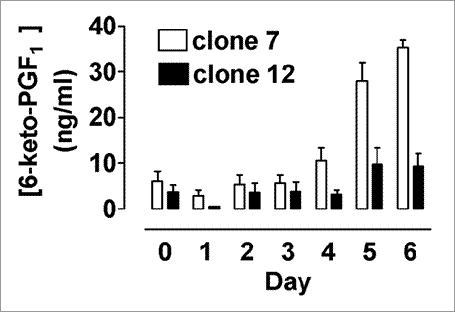087P Brighton
Winter Meeting December 2007 |
Generation of clonal populations of prostaglandin I2 producing rat vascular smooth muscle cells: potential utility for production of bypass vessels
Al-Rehan Dhanji1, Nicola Pearson1, David Bishop- Bailey1, Alex Shipolini2, Jane Mitchell3, Timothy Warner1
1William Harvey Research Institute, London, United Kingdom, 2Barts and the London NHS Trust, London, United Kingdom, 3National Heart and Lung Institute, London, United Kingdom
Currently, vein grafts remain an important choice of conduit for coronary artery bypass surgery in atherosclerosis, but because of poor long-term patency (Eagle et al., 1999) and the lack of reliable interventions to prevent vein graft failure the idea of “designer” bypass vessels is attractive. Here we have investigated, using rat cells, the possibility of selecting populations of vascular smooth muscle cells (VSMCs) with characteristics favourable for the production of vascular media, focusing upon the biosynthesis of PGI2.
Multiple monoclonal populations of VSMCs were derived from WKY 12-22 rat VSMCs by dilute plating and then characterised for their morphological characteristics and their production of PGI2. Selected clonal cell types were then further investigated for their influences on platelet aggregation, using light transmission aggregometry (Bedner et al., 1995), and adhesion, using the conversion of p-nitrophenyl phosphate to p-nitrophenol by platelet acid phosphatase, in a 96-well plate reader.
Morphologically distinct spindle-type VSMC clones (clone 7) produced greater amounts of PGI2 than epithelioid-type (clone 12) clones (Figure 1). Through this production of PGI2, spindle-type clones inhibited both platelet aggregation and platelet adhesion in response to adenosine diphosphate (0.1-30μM), arachidonic acid (10–1000μM), collagen (0.1-30μg/ml), adrenaline (0.001-100 μM), ristocetin (0.2-3.0mg/ml), TRAP-6 (0.1–30μM), and U46619 (0.1-30μM) (n=4 for each). For example, aggregations in response to ADP 10 μM and collagen 10μg/ml were reduced from 72±7% to 34±13% and 91±2% to 38±11%, respectively, in the presence of VSMCs.

Figure 1. Clonal spindle cells (clone 7) produce more PGI2 than clonal epithelioid cells (clone 12) when cultured in the presence of 15% serum. Data represents mean ± s.e.m from n=9 observations for each. p<0.01 between clonal types, 2 way ANOVA.
These results demonstrate that clonal VSMC populations with favourable characteristics such as the production of anti-thrombotic PGI2 can be isolated. Such defined, pure VSMC populations could potentially be used to produce vascular grafting media.
Bednar B et al., Thromb. Res 1995; 77: 453-463
Eagle KA et al., J. Am. Coll. Cardiol 1999; 34: 1262-1342
|


